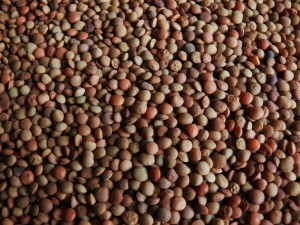MY BIG KEHUNA FOR LENTILS (Upper West Side)
Hi… I’m sick of being a KOHEN. Just too much responsibility.
I’m not selling my rites, but will trade it for LENTILS or a PRIUS.
But before you commit, you should learn more.
Even though the following goes into detail… all you have to do is get up three times a year in your dirty socks (and on high holidays) and hless the congregation. Not too hard. I recommend this for SINGLE MEN 18-32. After that stuff gets really complicated.
WHAT IS A KOHEN?
A Kohen (or Kohen, Hebrew ëÉÌäÅï, ‘priest’, pl. ëåäðéí, Kohanim) is a Jew who is in direct patrilineal descent from the Biblical Ahron. The Kohanim comprise a family dynasty within the larger Jewish Levitical tribe. Kohanim enjoy an honored status in Judaism, with certain designated rights and responsibilities[1].
Today, Kohanim have a distinct, honored status and remain bound by Torah and Rabbinic laws in Orthodox and, to a lesser extent, in Conservative Jewish communities.
Although Kohanim may assume their duties once they reached physical maturity, the fraternity of Kohanim generally would not allow young Kohanim to begin service until they reached the age of 20.[10] There was no mandatory retirement age. Only when a Kohen became physically infirm could he no longer serve.[11]
Certain imperfections could disqualify a Kohen from serving in the Temple. Since the Temple was a place of beauty and the services that were held in it were designed to inspire visitors to thoughts of repentance and closeness to God, a less than physically perfect Kohen would mar the atmosphere.
These blemishes include:
- blindness
- lameness
- an excessively low nasal bridge (such that a straight brush could apply ointment to both eyes simultaneously)
- disproportionate limbs
- a crippled foot or hand
- cataracts
- a white streak that transverses the junction between sclera (white part of the eyeball) and iris
- certain types of boils
- crushed testicles- That’s got to hurt!
A Kohen who was afflicted with one of these imperfections was held unfit for service. However, should it be a correctable imperfection, he would become eligible for service should the defect be corrected. At any time, he was permitted to eat of the holy food (same source as above, including adjacent verses and commentaries). Kohanim with these blemishes would be assigned to secondary roles in the Temple outside of performing the service itself.
BUT WAIT THERE IS SOME GOOD STUFF!
The twenty-four Kohanic gifts
The Kohanim were compensated for their service role in the Temple through 24 special “priestly gifts.” These were:[13]
Gifts given in the Temple area were portions of:
- an animal brought as a sin-offering
- a bird brought as a sin-offering
- a burnt-offering
- an offering for uncertain guilt
- a peace offering
- the olive oil offering of a metzora
- the two loaves of bread brought on Shavuot
- the Showbread
- the Mincha offerings
- the Omer offering
Gifts given within the walls of Jerusalem were:
- the firstborn of any domestic kosher animal
- the Bikkurim (first fruits)
- the inner organs of certain offerings
- the skins of certain offerings
Gifts which could be given inside or outside Jerusalem were:
- Terumah (a portion of the harvest)
- Terumat Ma’aser (a tithe of the Levite’s tithe)
- Challah (a portion of dough)
- the first shearing of the sheep
- the Forleg, Cheeks and Abomasum of all non-sanctified, ritually slaughtered domestic animals
- Pidyon haben (five silver shekels for the redemption of a firstborn Israelite son)
- a sheep or goat redeemed for a firstborn donkey
- a property or possession dedicated to the Temple without specifying to which use it is to be given
- inherited fields that were dedicated to the Temple and not reclaimed
- the theft repayment to a convert who has died, leaving no heirs.
Females, who did not serve in the Tabernacle or the Temple, were permitted to consume and/or derive benefit from some of the 24 priestly gifts. But if a Kohen’s daughter married a man from outside the Kohanic line, she was no longer permitted to benefit from the priestly gifts. Conversely, the daughter of a non-priest who married a Kohen took on the same rights as an unmarried daughter of a Kohen.
In every generation when the Temple was standing, one Kohen would be singled out to perform the functions of Kohen Gadol (High Priest). His primary task was the Yom Kippur service. Other Kohen Gadol unique acts included the offering of a daily meal sacrifice, and the prerogative to supersede any Kohen and offer any offering he chose.
Although the Torah retains a procedure to select a Kohen Gadol when needed, in the absence of the Temple in Jerusalem, there is no Kohen Gadol today.
NOW HERE IS WHERE THINGS GETS TRICKY!!!
Ritual defilement
The Kohanim formed a holy order. For the purpose of protecting them against ritual defilement, the Torah imposed on them the following rules for ritual purity, which are still maintained to a certain degree in Orthodox Judaism.
Kohanim are forbidden to come in contact with dead bodies. They are permitted, however, to become defiled for their closest relatives: father, mother, brother, unmarried sister, and child. Defilement of a Kohen to his wife -although not biblically explicit- is permitted by Rabbinical order.
• A Kohen is forbidden to enter any house or enclosure, in which a dead body (or part therof), may be found.[14 Practical examples of these prohibitions include: not entering a cemetery or attending a funeral; not being under the same roof (i.e. in a home or hospital) as a dismembered organ. The exact rules and regulations of defilement are quite complex, but a cursory rule of thumb is that they may not enter a room with a dead person or come within a few feet of the body. Proximity to the corpse of a non-Jew is less serious and may only be an issue if actual contact is established.
•A male Kohen may not marry a divorcee, a prostitute, a convert, or a dishonored woman (Hebrew “çììä”).[18] A Kohen who enters into such a marriage loses the entitlements of his priestly status while in that marriage. The kohen is not allowed to voluntarily forego his status and marry a woman prohibited to him.[19]
Talmudically, were a Kohen to marry in disregard of the above prohibitions, his marriage would be effective. Children born of the union do not have mamzer status. However, these children are termed Chalal (“disqualified”) and do not possess Kohen status.
The Kohen Gadol may marry a virgin only.
During the period of the Holy Temple, Kohanim were required to abstain from wine and all strong drink before and while performing their priestly duties.
LOOK IF THE MESSIAH COMES IN YOUR TIME…you are in great shape. If PETA isn’t up your butt, you could make a nice living.


